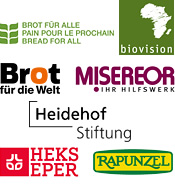News
31.07.2015
UN projects world population to hit 9.7 billion by 2050

The current world population will increase from 7.3 billion today to 9.7 billion in 2050 and 11.2 billion in 2100, according to the latest UN projections. India is expected to become the most populous country, surpassing China within the next seven years. Nigeria will overtake the United States to become the world’s third largest country within 35 years from now. The new report, published on Wednesday by the UN’s Department of Economic and Social Affairs (UN DESA), attributes the increase in the world’s population to a small number of high-fertility countries, which already have large populations. By 2050, six countries will have more than 300 million inhabitants: China, India, Indonesia, Nigeria, Pakistan and the USA. In the period 2015-2050, half of the world’s population growth is expected to happen in just nine countries: India, Nigeria, Pakistan, Democratic Republic of the Congo, Ethiopia, Tanzania, the USA, Indonesia and Uganda. The UN figures project Africa to remain the continent with the highest fertility rates, accounting for more than half of the world’s population growth between 2015 and 2050. In 28 African countries, populations are expected to double, and by 2100, ten African countries are projected to have increased fivefold: Angola, Burundi, Democratic Republic of Congo, Malawi, Mali, Niger, Somalia, Uganda, United Republic of Tanzania and Zambia. “The concentration of population growth in the poorest countries presents its own set of challenges, making it more difficult to eradicate poverty and inequality, to combat hunger and malnutrition, and to expand educational enrolment and health systems, all of which are crucial to the success of the new sustainable development agenda,” said John Wilmoth, Director of the Population Division at UN DESA. Although global fertility rates are declining in almost all parts of the world, this is being offset by countries with large populations and a high number of children born per woman. The overall slowdown in population growth will cause the world population to become older. Globally the number of people aged 60 or older is expected to double by 2050 and more than triple by 2100. (ab)
27.07.2015
Agriculture is much older than previously thought, new study

Crop cultivation may have developed 11,000 years earlier than previously thought, according to a new study by Israeli archaeologists published in the journal PLOS ONE. The researchers believe they have discovered evidence of the earliest known farming attempts by humans in Ohalo II, a 23,000-year-old hunter-gatherers’ sedentary camp on the shore of the Sea of Galilee, Israel. Until now, scientists believed that the origins of farming dated back around 12,000 years ago to Iraq, the Levant, parts of Turkey and Iran, an area called the Cradle of Civilisation. “While full-scale agriculture did not develop until much later, our study shows that trial cultivation began far earlier than previously believed, and gives us reason to rethink our ancestors’ capabilities,” said Prof. Marcelo Sternberg of the Department of Molecular Biology and Ecology of Plants at Tel Aviv University, one of the authors of the study. “Those early ancestors were more clever and more skilled than we knew.” The researchers examined more than 150,000 specimens of plant remains retrieved from the Ohala II site. The well preserved hunter-gatherer settlement was discovered in 1989 when the water level in the sea of Galilee dropped due to drought and excessive water extraction. The researchers determined that early humans there had gathered over 140 species of plants. These included 13 known weeds mixed with edible cereals, such as wild emmer, wild barley, and wild oats. Since weeds thrive in cultivated fields and disturbed soils, a significant presence of weeds species is widely considered an indicator of systematic cultivation, according to the study. The researchers also found a grinding slab, a stone tool used to extract cereal starch granules, as well as a distribution of seeds around this tool, reflecting that the cereal grains were processed for consumption. (ab)
20.07.2015
Bread may contain carcinogenic weed killer, campaigners warn

Bread sold in the UK is being contaminated with a weed killer recently categorised as “probably” carcinogenic by the World Health Organisation (WHO), campaigners have warned. In 2013, one third of bread tested by the government’s expert committee on pesticide residues in food (PRiF) contained a measurable amount of glyphosate, the main component of Monsanto’s Roundup herbicide. In 2014, the experts still found traces of the weed killer in as much as 15% of UK bread. Wholemeal bread, which contains more of the wheat grain, may be most affected. The Soil Association has now called for an immediate ban on glyphosate ahead of this year’s harvest, urging farmers and the milling industry not spray the weedkiller on wheat crops pre-harvest. Policy director Peter Melchett said: “We cannot ignore the World Health Organisation’s findings that glyphosate is a probable cause of cancer - the risks are too great. According to the campaigners, the use of the weedkiller has risen by 400% in the last 20 years in UK farming. Glyphosate is one of the three pesticides regularly found in routine testing of British bread. “Although the quantities found are well below the official safety level, this limit was agreed before the latest scientific findings about the dangers of glyphosate”, Peter Melchett said. In March, the WHO’s International Agency for Research on Cancer concluded in a report that glyphosate “probably” causes cancer in humans. Last week, Professor Christopher Portier, one of the co-authors of the report, reiterated the IARC’s conclusions, and said: “Glyphosate is definitely genotoxic. There is no doubt in my mind.”(ab)
13.07.2015
US$267 billion per year needed to eradicate world hunger
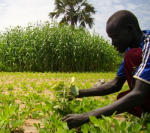
Ending world hunger sustainably by 2030 will require an estimated $267 billion per year for investments in rural and urban areas and in social protection, the United Nations said on Friday. Roughly $160 annually would be needed for each person living in extreme poverty over the next 15 years to provide access to food and improve livelihoods. “Given that this is more or less equivalent to 0.3 percent of the global GDP, I personally think it is a relatively small price to pay to end hunger,” said José Graziano da Silva, Director-General of the UN Food and Agriculture Organisation (FAO). The report was published by FAO, the World Food Programme and the International Fund for Agriculture Development ahead of a major international conference on financing for development, starting on 13 July in Addis Ababa, Ethiopia. Worldwide, almost 800 million people are still chronically undernourished, most of them in rural areas. “The message of the report is clear: if we adopt a ‘business as usual’ approach, by 2030, we would still have more than 650 million people suffering from hunger”, Graziano da Silva said, “This is why we are championing an approach that combines social protection with additional targeted investments in rural development, agriculture and urban areas that will chiefly benefit the poor,” he explained. Social protection measures would cost an additional $116 billion per year – two thirds of them intended for rural areas – while some $151 billion in additional pro-poor investments would be required to stimulate income generation benefiting the world’s poorest. The report notes that social protection in the form of cash transfers are an effective means of eliminating hunger. This money could make more diverse and thus healthier diets affordable to the poor, improving nutrition and also fighting micronutrient deficiencies. Additional investment should ensure that people living in extreme poverty will eventually be able to provide for themselves. According to the report, it is necessary “to boost both private and public investment to raise rural and agricultural productivity and incomes, as well as to promote more productive, sustainable and inclusive food systems.” Small-scale agricultural producers and rural entrepreneurs could make a decisive difference. However, formal systems of credit and insurance often discriminate against them, especially small family farmers.“ Eliminating hunger is a key issue of the Sustainable Development Goals (SDG) of the new post-2015 agenda, to be adopted by world leaders in September to replace the UN Millennium Development Goals. (ab)
08.07.2015
Soil erosion a major threat to Britain's food supply, warns report

Large areas of farmland in the United Kingdom are at risk of becoming unproductive within a generation due to soil erosion, according to a government advisory group. A recent report from the Committee on Climate Change (CCC) has warned that soils are being degraded and eroded at unsustainable levels in some areas, such as the East Anglian Fens. This could reduce agricultural productivity and lead to increased reliance on food imports at a time of growing global demand and rising prices. “Soil is a very important resource which we have been very carefree with. At the moment we are treating our agricultural soils as though they are a mined resource – that we can deplete – rather than a stewarded resource that we have to maintain for the long-term future,” said Lord Krebs, chairman of the CCC’s adaptation sub-committee. In its progress report on adaptation to climate change, the committee says that soil erosion is the result of current methods of intensive agriculture, with “deep ploughing, short-rotation periods and exposed ground leading to soil erosion from wind and heavy rain”. Britain’s soil quality has been severely damaged over the past decades. The country has lost 84% of its fertile topsoil since 1850, with the erosion continuing at a rate of 1cm to 3cm a year. The experts warn this rate of loss is not sustainable as soil can take a hundred years or more to form. “The most fertile topsoils in the east of England – where 25% of our potatoes and 30% of our vegetables are grown – could be lost within a generation,” said Lord Krebs. Climate change could make soil erosion and degradation even worse due to rising temperatures and water shortage, as well as the frequency of heavy rainstorms, which wash fertile topsoil away. Trevor Mansfield, head of policy at the Soil Association, a Britain’s leading non-profit organisation campaigning for organic agriculture, commented on the committee’s results: “For the first time, this report highlights the critical red list status of British soils, threatening our climate and future food production.” Soil Association has called on the UK Government to commit to a target to achieve a 20% increase in soil organic matter in UK arable and horticultural soils over 20 years, to protect the country’s ability to grow food in the face of a changing climate. (ab)
30.06.2015
UN report: 2.4 billion people worldwide lack access to sanitation
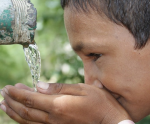
The world has made little progress on sanitation and drinking water, leaving 2.4 billion people without access to improved sanitation facilities. According to a new report, released Tuesday by the UN Children’s Fund (UNICEF) and the World Health Organisation (WHO), the lack of access to sanitation threatens to expose the world’s poorest to preventable health risks. One in three people on the planet, or 2.4 billion, still use unimproved sanitation facilities and one in eight people (946 million) defecate in the open. The report tracks access to drinking water and sanitation against the Millennium Development Goals (MDGs). Although 2.1 billion people have gained access to improved sanitation facilities since 1990, the MDG target for sanitation will be missed by almost 700 million people. Moreover, one in ten (663 million) people still lack improved drinking water sources, including 159 million who depend on surface water. Eight out of ten people still without improved drinking water sources live in rural areas. Worldwide, 2.6 billion people have gained access to an improved drinking water source since 1990 but the WHO underlines that ‘improved sources’ are not necessarily safe. At least 1.8 billion people use drinking water that is contaminated with faeces. “Until everyone has access to adequate sanitation facilities, the quality of water supplies will be undermined and too many people will continue to die from waterborne and water-related diseases,” said Dr. Maria Neira, Director of WHO's Department of Public Health, Environmental and Social Determinants of Health. Contaminated water and poor sanitation are linked to transmission of diseases such as cholera, diarrhoea, dysentery, hepatitis A, typhoid and polio. Some 842 000 people are estimated to die each year from diarrhoea as a result of unsafe drinking-water, sanitation and hand hygiene. And the practice of open defecation is also related to a higher risk of stunting, or chronic malnutrition, which affects 161 million children across the globe, leaving them with irreversible physical and cognitive damage. “To benefit human health it is vital to further accelerate progress on sanitation, particularly in rural and underserved areas,” says Dr Neira. (ab)
23.06.2015
Wild bees are worth billions to farmers worldwide, study finds

Wild bees provide crop pollination services worth billions to the food system, according to a new study published last week in the journal Nature Communications. Pollination by wild bees contributes on average $3,251 per hectare per year to crop production, while pollination services by managed honeybee colonies are worth $2,913 a hectare. The international study team, which included researchers from the University of Reading, used data from 90 studies and 1,394 crop fields around the world, monitoring the activities of nearly 74,000 bees from more than 780 species. The scientists estimated the overall value of the bees by examining how heavily food crops depend on their pollination services to grow. They then looked at how much the sale of these produce contributes to the UK economy. They found that bees contribute £651 million (around $1 billion) to the UK economy a year, £150 million ($236 million) more than the Royal Family brings in through tourism. The figures show that the overall economic value of bees has increased by 191 per cent between 1996 and 2012. Almost 85% of the UK’s apple crop and 45% of strawberry plants rely on bees. Professor Simon Potts, director of the Centre for Agri-Environmental Research (CAER) at the University of Reading, said “Putting a cash value on ecosystem services is helpful to highlight to politicians and farmers just how important nature is to the bottom line.“ But he added that “thinking purely about today’s profits is pointless if it comes at the expense of the future sustainability of our countryside and our food supply.“ The scientists also found that most of the pollinating work was done by a handful of common species. Only 2% of wild bee species visited about 80% of bee-pollinated crops worldwide. However, conservation efforts should be targeted at a wider number of species - even those that currently contribute little to crop pollination - in order to maintain biodiversity and ensure future food security. “The few bee species that currently pollinate our crops are unlikely to be the same types we will need in the future,” said Professor Potts. „Human history is full of examples of food crises caused by an over-reliance on a single crop or a dwindling number of species.” (ab)
- Telegraph: Bees contribute more to British economy than Royal Family
- The Guardian: Bees are worth billions to farmers across the globe, study suggests
- University of Reading: Britain needs ‘super-sub bees’ to maintain food supply
- Nature Communications: Delivery of crop pollination services is an insufficient argument for ...
16.06.2015
France to ban Monsanto’s Roundup weedkiller from garden centres

France has announced a ban on over-the-counter sales of Monsanto's weedkiller Roundup at garden centres after glyphosate, the active ingredient in Roundup, was classified as potentially harmful to human health. French Environment Minister Ségolène Royal told France 3 television on Sunday, “France must be on the offensive with regards to the banning of pesticides”. “I have asked garden centres to stop putting Monsanto’s Roundup on sale” in self-service aisles, she said. Royal did not specify how she would enforce a ban. Glyphosate was introduced by Monsanto in the 1970s under the brand name Roundup and is the world’s most widely sold herbicide used by farmers and amateur gardeners alike. In March, the International Agency for Research on Cancer (IARC), an arm of the World Health Organisation (WHO), classified glyphosate as “probably carcinogenic to humans”. That prompted calls from public officials, health experts and consumers worldwide for a ban on the pesticide. Some retailers across Europe have already started to remove Roundup from their shelves. German retail giant REWE Group announced in May that its 350 ‘toom Baumarkt DIY’ stores would no longer be selling products containing glyphosate by 30 September 2015 at the latest. In Switzerland, supermarket chains Coop and Migros both have removed glyphosate products from their product range. The French move is part of a wider effort to reduce the country's pesticide use. The French parliament earlier adopted a law which would restrict self-service sales of plant protection products for domestic gardeners from 2018. Sales would be limited to certified vendors, a full ban on pesticides in home gardens would take effect from 2022. France, the EU’s largest agricultural producer, had the ambitious goal of cutting pesticide use by half from 2008 to 2018. In late January, however, French Minister of Agriculture, Stéphane Le Foll, prolonged the deadline to 2025. (ab)
- Independent: Roundup weedkiller banned from French garden centres over 'probable' link to cancer
- IBT Media Inc: Segolene Royal Calls For French Ban On Monsanto's Roundup Herbicide
- Reuters: French minister asks shops to stop selling Monsanto Roundup weedkiller
- Le Monde: Ségolène Royal veut stopper la vente du désherbant Roundup de Monsanto
09.06.2015
Most Americans could be fed entirely by local farms, research shows
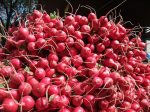
Most Americans could be fed entirely by food grown within 100 miles of their homes, according to new research published last week in the science journal Frontiers in Ecology and the Environment. The study, led by professor Elliott Campbell from the University of California, Merced, mapped the potential of every U.S. city to obtain food through local food networks. The researchers found that most areas of the U.S. could feed 90% of the local population with food grown or raised within 50 miles, making agriculture more sustainable. Campbell said the popularity of “farm to table” has increased significantly over the past few years as people become more interested in supporting local farmers. “Farmers markets are popping up in new places, food hubs are ensuring regional distribution, and the 2014 U.S. Farm Bill supports local production - for good reason, too,” Campbell said. “There are profound social and environmental benefits to eating locally.” Campbell and his students used data about land productivity from the U.S. Department of Agriculture and looked at the farms within a local radius of every major population center in the country. By comparing the potential calorie production to the population of each city or town, they arrived at the percentage of the population that could be supported entirely by locally grown food. Although local food potential has declined over time due to limited land resources and growing populations and urbanisation, particularly in some coastal cities, the researchers were surprised at how much potential still remains. Most areas could still sustain between 80% and 100% of their populations with food grown or raised within 50 miles. New York City, for example, could feed only 5% of its population within 50 miles, but as much as 30% within a radius of 100 miles. The greater Los Angeles area could feed half the population within 100 miles. Plant-based diets can also make a difference. San Diego, for example, could feed 35% of its population based on the average U.S. diet, but as much as 51% of the population if people switched to plant-based diets. According to the study, local food systems may facilitate agroecological practices that conserve nutrient, energy, and water resources. “One important aspect of food sustainability is recycling nutrients, water and energy. For example, if we used compost from cities to fertilise our farms, we would be less reliant on fossil-fuel-based fertilisers,” Campbell said. “But cities must be close to farms so we can ship compost economically and environmentally. The scientists hope their maps will provide the foundation for discovering how recycling could work. (ab)
02.06.2015
Study finds organic agriculture can be more profitable to farmers
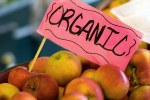
Organic agriculture can be much more profitable than conventional agriculture, according to new research published this week in the journal Proceedings of the National Academy of Sciences. The study by two Washington State University professors shows that the profit margins for organic agriculture are significantly greater as long as farmers can charge higher prices than their non-organic counterparts. “The reason we wanted to look at the economics is that more than anything, that is what really drives the expansion and contraction of organic farming – whether or not farmers can make money,” said David Crowder, from WSU’s Department of Entomology. The scientists analysed the financial performance of organic and conventional agriculture from 40 years of studies covering 55 crops grown on five continents. Out of 129 initial studies, 44 were included in the meta-analysis. The study also included profit data for multiple crops grown over several seasons to better reflect how farmers profit from agriculture. The researchers found that premiums paid to organic farmers ranged from 29 to 32% above conventional prices. Organic farming practices require farmers to spend 7 to 13% more on labour, while other costs were not significantly higher. Even with organic crop yields being 10 to 18% lower, the breakeven premiums necessary for organic profits to match those of conventional farmers were only 5–7%. “That was a big surprise to me,” said Reganold, a soil scientist and organic agriculture specialist. “It means that organic agriculture has room to grow; there’s room for premiums to go down over time. But what we’ve found is that the premiums have held pretty steady over the 40 years represented in the study.” According to the study, farmers converting to organic face many problems and uncertainties as the transition period for organic certification exposes farmers to financial risk when their yields drop but they are not yet receiving premiums. The authors suggest that government policies could further boost adoption of organic farming practices, especially during the transition period, often the first three years. The study neither forecasts the effects of a major shift to organic production, which could result in lower prices due to increased supply nor does it account for the environmental costs or ecosystem services from good farming practices. But according to the authors, organic farming with its multiple environmental benefits can contribute a larger share in sustainably feeding the world. (ab)
